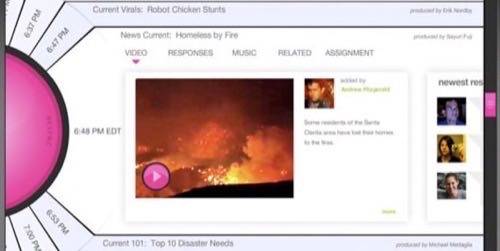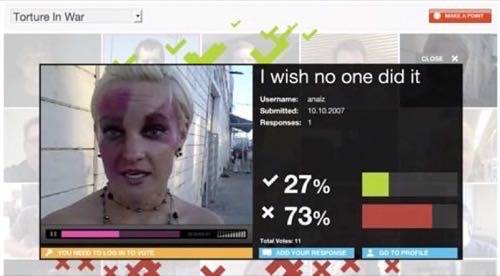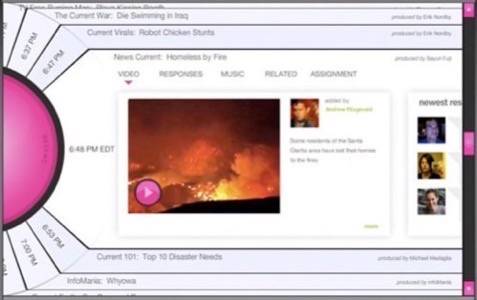Current Media, the parent company of Current TV and Current.com, has filed for a $100 Million IPO on NASDEQ. Current was famously co-founded by ex Vice President Al Gore. IPOs (Initial Public Offerings) have been thin on the ground in the Web 2.0 era, but in Current’s case the money will be used for expansion of their TV network as well as their website offering. We covered Current TV’s internet plans in July last year and their new user-generated website Current.com in October.

In the IPO filing, Current describes their media model as “innovative but unproven”.
The differences include Current “interacting with our TV network to provide a participatory “two-screen” experience”; “enabling user-generated content and participation”, which it says differentiates it from “traditional “top-down” news and information websites such as CNN.com, NewYorkTimes.com and Yahoo!”; and “providing programming assistance and editorial oversight, as compared to other social news sources, such as del.icio.us and digg.com.”
For an in-depth analysis of the Current media model, which utilizes the Internet and user generated content far more than its TV network rivals, here is another look at our product-focused report on Current:
Introduction to Current
Current was founded by Joel Hyatt and Al Gore and launched August 1, 2005. Gore serves as its Chairman and has understandably been the focus of much of the media coverage Current has received. [FWIW I sat in Al Gore’s office in my visit, although the man himself wasn’t present] The TV Network and accompanying website specifically targets “young adults” – i.e. the MySpace and Facebook generation. The ‘read/write’ principle is very much in effect on the Network and website, because Current encourages TV viewers to create content and engage with it on a very interactive level. For example viewers can create their own ads, called vcams (for ‘viewer created ads’; I was told that viewers much prefer them to professional ads). As of now, the Current TV Network reaches 52 M people worldwide, 42 M of those in the US.
Current’s Pod format – more on this below

As a Reuters report on the current.com launch noted, Current aims to be “the first fully integrated online and television network”. Website users can create their own content, and there is a digg-style interface for voting on it. Comments on stories may include text, video, photos and other forms of media. For example users can post a YouTube video. The Current folks told me that in the private beta, they noticed that users would post videos and other media that was only tangentially related to the original story – which they said produced a more diverse conversation around a topic. Current.com was in a private beta for about 8 weeks before its launch last week.
Another thing to note is that Current is not purely user-generated – it has a strong editorial voice and many of the frontpage stories are editorially selected.
Viewpoints
The first innovative feature I want to highlight is Viewpoints, which is a part of the .com site that Al Gore himself envisaged. It’s a facewall based around a specific topic; usually political or current affairs based. When you first navigate to the Viewpoints page, there is a tagcloud of topics, which then desolves into a facewall of the main topic – today it is “Torture In War”. When you click on a face, a 1 minute video of that person opens. There are 11-12 topics currently, many of them related to the US election. Al Gore himself has posted to Viewpoints, but the Current team were quick to tell me that Gore is just one of the wall of faces – and doesn’t get special treatment. Gore hopes this type of system will encourage politicians to become more topic-focused in the election and other politcal issues.

The design is stunning, but more importantly the format works – you’re limited to 1 minute to make your point and the community can vote and respond with their own 1-minute videos. The example below shows a video with a 73% disapproval rating and it was responded to by 1 person. The Current folks told me that this format results in more nuanced, personal opinions. Because it is “peer to peer” (in the human sense), people can quickly influence their peers by uploading their viewpoint. What’s more, the best of these clips will be run on Current’s TV shows.

‘On TV’ and the Concept of Pods
The other main feature on the Current.com website that impressed me was the wagon wheel-like TV programming guide. It is under the tab labeled On TV. It uses a concept called “pods”, which were described to me as Current’s form of programming. Each pod is a chunk of content, displayed on an interactive wheel. Here is a screenshot:

As with Viewpoints, the pods are visually very slick and interactive. I really have to tip my hat to the Current designers, they have done a great job with the site.
The philosophy behind the pod is fascinating too. It’s designed to cater to their young audience – who are prone to multi-tasking. I was told that 70-75% of Current’s audience has a computer in the room while they watch TV. And while they are watching TV, they are interested in learning more about what they’re watching – e.g. constantly refreshing the website and getting content from their community. That’s the theory anyway, and the pod format was built around it. The UI makes it very simple to consume the media (video, music), click on responses (uploaded community videos), find related information, even do “assignments” about the topic. As well as showing what times the shows are on TV, of course.
Current’s Joshua Katz (President of Marketing) described the pod to me as “what FM radio used to be in the early days”, when one song led to another and there were connections – and (back then) there was still a wide variety of content.
A note on the Current demographic: it is roughly 18-34 years old, but perhaps more importantly they’re targeting “influencers” – people who want new info constantly, share it via the Web, and have on average 25-60 people who they interact with online (IM with, etc). This is the Internet age audience, not couch potatoes with a remote control glued to their hand.
Conclusion: Reaching for New Form of TV
What I like about Current, apart from the awesome design, is that they’re attempting to change the way television is consumed and created. It’s a much more interactive experience, where the audience participates and creates.
I buy the theory that young people are watching tv and on a computer accessing the Web at the same time. So the pod format is, in my view, an innovative new UI built around this new form of television watching. It’s a bit like when Google created Gmail – they built it for the Web, rather than copying the desktop paradigm. Likewise, Current has developed their pod UI based on a new form of TV/Web experience, rather than copying traditional TV programming formats.
Of course, for any TV Network, the content has to be compelling – so it remains to be seen how Current fares long-term on that count. But on the technology and concepts behind Current, what do you think? Is this type of TV/Web format the future of TV?





















